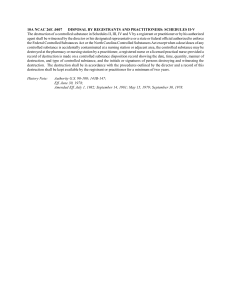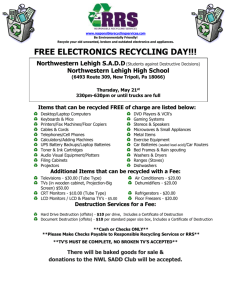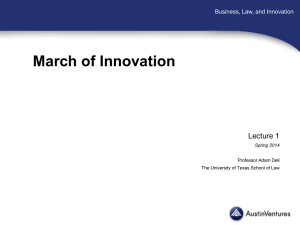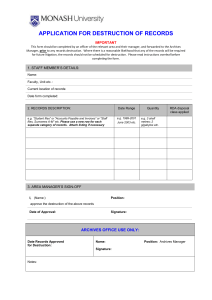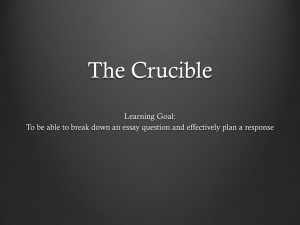“Terminator VIII”
advertisement
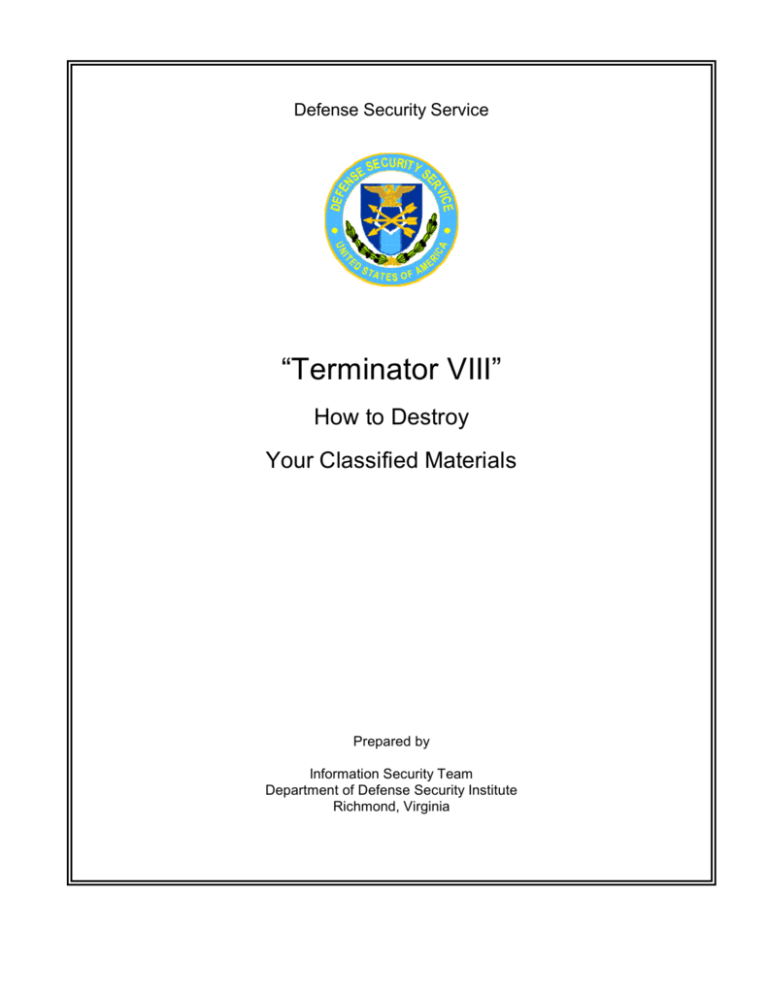
Defense Security Service “Terminator VIII” How to Destroy Your Classified Materials Prepared by Information Security Team Department of Defense Security Institute Richmond, Virginia September 1992 Destruction Methods and Procedures This pamphlet summarizes the DoD and some Component requirements for destruction of classified materials. The first section contains questions and answers for some common problems related to destruction of classified materials. The second section contains detailed information on various destruction methods. The third section is a quick summary of the DoD 5200.1-R procedural requirements. In many instances DoD and the Components have not given recommendations or guidance pertaining to some of the destruction procedures and methods. If your regulation does not give you specific guidance on some of the issues, you may want to use the guidance provided by another component in order to reach a practical and secure method of destruction. SECTION I QUESTIONS AND ANSWERS Q: Do I need to be appointed as a destruction official in order to destroy classified materials? A: No, anyone who is authorized access to the classified materials is allowed to destroy those materials without being appointed as a destruction official. Remember, however, that the principles of a proper security clearance and the need-to-know must still be enforced for materials that are to be destroyed. There are two general categories of people who are authorized to destroy classified materials. The first category is composed of people who are considered custodians of the materials, that is, those who work with it and are responsible for safeguarding it. These people naturally have the proper clearances and need-to-know for access to the materials. The second category is composed of people who are designated as central destruction officials for their respective organizations. These people must have the proper level of clearance in order to do their job (which is destroying classified materials). The need-to-know is considered inherent with their job function. Q: Do I need to get permission from the originator of a classified document prior to destroying it? A: Only if there is a statement on the document that tells you to so notify the originator. Otherwise, you do not need permission to destroy a classified document (subject to the conditions noted in the next question). Q: I have a classified document that I have no operational need to retain. Am I authorized to destroy it? A: If you have no operational need to retain a classified document and if there is no historical value to the document, you should promptly and properly destroy the document. If there is historical value to the document, you must retain it in accordance with records management procedures (you must retain it despite the lack of operational need for the document). Q: How do I find out if a document has historical value? A: Check with your records management office and (if your organization has one) check with your unit historian. Q: I see the marking “Declassify on: O.A.D.R.” on many documents. Does that marking mean that I cannot destroy the document until the originator of the document tells me that I may do so or does it mean that I must return the document to the originator when I no longer have a need for it? A: Neither. That marking means that in order to find out if you can declassify any of the information in the document, you must ask the originator. If there is no historical value to the document, it should be properly destroyed as soon as it has no operational value. Q: What are the most commonly used methods for destroying classified paper products? A: The most commonly used methods for destroying paper products are burning and shredding. Q: Are there any precautions that I should be aware of when burning classified materials? A: Yes. The first precaution is you must ensure that the burning is complete. You should stir the ashes to get this complete burn. You should not simply throw the materials into the incinerator or furnace and then leave. You should stay at the site to ensure a complete burn by checking the residue. The destruction process is complete only when reconstruction of the material is impossible. The second precaution is you must have a burn facility that meets environmental emission standards (both state and federal). Q: Must I use a furnace or incinerator dedicated solely for security destruction or can I use an incinerator at a hospital or a furnace at an office building or some other similar facility? A: You may use a hospital's incinerator or an office building's furnace because burning itself is an authorized method for destroying classified materials. If you do use such an incinerator or furnace, you must not allow unauthorized access to the materials until the burning process is complete. You must ensure that the materials are completely burned and that reconstruction of the material is impossible. Q: I'm thinking of purchasing a shredder for classified materials destruction. How do I know what is authorized and what is not? A: DoD does not specify to what size the shredders must cut the materials. It is up to each Component and Agency to set the size requirements for the shredded particles. If your shredder meets that maximum size requirement set by your Component or Agency headquarters, you may use that shredder. The first two charts in Section II of this pamphlet show the standards that the Components have imposed for the three levels of classified information. Q: Can I use my shredder to destroy microfilm and microfiche? A: In most instances, a shredder should be used to destroy paper products only. High data density materials, such as microfiche, should not be destroyed in a shredder because of the large size of the shred material compared to the minuscule size of the image. In addition, the plastic material that the microfilm and microfiche is made of can cause most shredders to either jam or burn out. Paper clips, staples, and other metallic objects should not be placed in a shredder. Check the charts in Section II for other precautions related to materials that can be and cannot be shredded. Q: I've heard some people use the term “secure volume.” What is that? A: "Secure volume" is the concept of shredding a lot of similar materials at one time in order to make it more difficult for someone to put all of the pieces together again. Thus, DoD recommends that you do not shred just one sheet of paper containing classified information and, subsequently leave it in the shred bag. You should shred other similar (in color and print text) sheets of paper (classified or unclassified) so the shredded pieces will be mingled. This will make it extremely difficult, if not impossible, for someone to reconstruct the classified sheet of paper. A good rule of thumb is to shred and mix at least twenty sheets of paper. Q: Do I have to burn the shredded pieces after I have completed shredding classified materials, or can I simply discard them? A: As long as the shredder that you are using cuts the materials down to the maximum size dictated by your Component Headquarters and you use the secure volume concept, you can discard the shredded pieces as unclassified material. You don't have to burn the shredded materials or execute any additional destruction process to the materials. Q: Are there other machines, in addition to shredders, that I can use to destroy classified materials? A: There are pulpers and pulverizers (pulverizers include hammer mills, choppers, and hoggers) that can be used to destroy classified materials. These are rarely found in an office environment. When used, they normally serve as the centralized destruction means for an installation and usually are used for large volume destruction. Specifications for approved pulpers and pulverizers are set by the Components and Agencies, not by DoD. Q: What are pulverizers? A: Pulverizers crush the material and force the material through an internal screen. The size of the screen determines the size of the material that passes out of the machine. The first two charts in Section II show the maximum size of the screen openings that the Components have authorized for the destruction of classified materials. The charts also show some precautions that you should take when using a pulverizer. In general, pulverizers are noisy and dusty. Q: What are pulpers? A: Pulpers work in the same fashion as pulverizers except that they add water to the material that is being destroyed. As in pulverizers, the size of the internal screen that the material is forced through determines whether the pulper is approved for use in destroying classified materials. The first two charts in Section II show the size of the screen openings that are authorized by the Components. The charts also show some precautions that you should take when using a pulper. Q: I have some non-paper materials that I need to destroy. What can I use? A: You can use some of the pulverizers. Check the manufacturer's specifications to see what types of materials a particular pulverizer will destroy. Q: Am I authorized to use a piece of equipment that meets the size specifications shown in the first two charts of Section II to destroy COMSEC and SCI materials? A: Only if that piece of equipment is on the approved destruction equipment list published by NSA. COMSEC and SCI may be destroyed only with equipment designated on that particular list. There are many pieces of equipment that will produce the particle sizes shown in the first two charts of Section II but not all of them are authorized for use in destroying COMSEC and SCI. (They may, however, be used to destroy collateral classified materials.) Q: The first two charts in Section II show only four methods for destroying classified materials (burning, shredding, pulping, and pulverizing)? Are these the only methods of destruction available? A: No, there are other methods that could be used, such as melting of the materials or chemical decomposition. However, neither DoD nor the Components have published standards for these methods. So if you should use these methods, you have no criteria that you can use to measure against to tell you whether the results that you have are sufficient. The general guideline for sufficiency of these methods is “if the information cannot be recovered or reconstituted after the destruction process is over, then that destruction process is okay.” Q: How can I erase various AIS media so I can declassify them and reuse them in an unclassified environment? A: There are no DoD-wide standards for such actions. The Components have adopted some of the NSA standards for erasing and declassifying AIS media. The last two charts in Section II provide you with a brief overview of various techniques concerning AIS clearing, purging, and destroying and the page following the two charts gives you related information. Check NCSC-TG-025, Version 2, – A Guide to Understanding Data Remanence in Automated Information Systems – and your Component or Agency regulations for further specifics concerning erasing and declassifying AIS media. The most common method used for erasing AIS media is degaussing. Q: Am I authorized to destroy Top Secret materials by myself? A: No. The requirement is to have two people witness the destruction of the materials (in other words, two people directly involved with the actual destruction process). Those two people must then fill out a destruction record which certifies that they witnessed (watched) the destruction of the materials. The destruction record must be then kept for at least two years. (In many instances, the record is maintained with the Top Secret register and kept on file with the register.) Q: Must a destruction certificate be completed for Secret material destruction? A: If only one person does the destruction of Secret materials, a certificate must be completed and kept on file for at least two years. If two of you witness (watch) the destruction, then no certificate is necessary. On the other hand, Confidential materials require only one witness (the person actually doing the destruction) and no record keeping. Q: We use burn bags at our facility. Am I authorized to sign a destruction certificate for Top Secret materials as soon as I place the materials into a burn bag? A: You may complete a destruction certificate as long as the following conditions are met: (1) two people witness the whole process, (2) the bag is sealed in such a way that tampering with it will be evident, (3) the bags are serially numbered, and (4) the subsequent handling of the bags are recorded. SECTION II The following section contains detailed information on the various destruction methods. The first two charts in this section show you the commonly used methods for destroying Top Secret materials and Secret/Confidential materials. Then comes some information on other destruction methods and some information on how to destroy materials other than paper products. Lastly, there are two charts on AIS media clearing and destruction processes and following the AIS charts is some related information. General information pertaining to the first two charts: • They detail the size specifications that must be met in order to have an authorized piece of equipment. • The only difference in size specifications between Top Secret destruction and Secret/Confidential destruction is in the shredder criteria. • The Air Force does not impose their own set of size criteria but rather it uses the specifications set by the other Components. • Some non-paper materials require special handling. The charts provide information on those procedures. TOP SECRET Burning Shredding1 Authorized method for destruction of all levels of classified materials. Army2 Navy3 AF Army Navy AF Class I Class I if purchased after Apr 88. * 1/4 in. screen 1/4 in. screen * Person must ensure that destruction is complete and reconstruction is impossible. Materials stirred to ensure all completely burned. Unburned residue treated as classified material. Environmental standards must be met. Pulping4 Pulverizing5 Class II if purchased before Apr 88. Army6 Navy Hammermill - 1/4 in. screen Hammermill - 3/32 in. screen Chopper - 3/16 in. screen Hogger - 1/4 in. screen AF * Chopper - 3/32 in. screen Hogger - 1/4 in. screen * Air Force requirement: Use devices approved by other components and listed in TA 006 or use devices that meet FEDSPECs and are approved by MAJCOM or SOA Commander or equivalent. 1. Per FEDSPEC FF-S-001169 Class I shredder: 1/32 (+ 1/64 tolerance) x 1/2 inch crosscut. Volume of .02344 sq. in. or 15.12 sq mm. Class II shredder: 1/32 inch continuous strip. Do not use shredders for microfilm, microfiche, or other high density material. 2. Army advises to use for nonwater-soluble plastic coated, waxed paper, or similar material (e.g. carbon paper). Can be used for typewriter ribbons (mylar, nylon, and cotton-based ribbon) but must be heavy-duty (l.5 horsepower or larger) crosscut shredder and ribbon fed-in so sliced across longest dimension. Ribbon should be radially slit from the reel with a razor blade. Do not use a standard office-type class I or II shredder. 3. Navy advises that microforms can be shredded with Data Tech Model 003 and 004 shredders. 4. Per FEDSPEC FF-P-00800A Screen size determines size of material that passes through it. Not good for plastic-based or water repellent-type paper. Metal, glass, staples, paper clips, etc. should not be put into a pulper. 5. Per FEDSPEC FF-P-00810A Although not specified by FEDSPEC, this category includes hammermills, choppers, hogger, and hybridized disintegrators. Used for nonwater-soluble plastic coated, waxed paper, or similar material (e.g. carbon paper). Hammermills are used for paper, lightweight plastics and wood, glass slides, aluminum offset plates, and other easily breakable items. Typewriter ribbons (mylar, nylon, and cotton-based ribbons) should be removed first from the reel by radially slitting with a razor blade. Hammermills are noisy and dusty. Choppers are used for paper-based materials. Typewriter ribbons (mylar, nylon, and cotton-based ribbons) should be removed first from the reel by radially slitting with a razor blade. Hoggers and hybrids are used for high volume destruction (1 ton or more per day). 6. Army advises that hammermills used to destroy high-data density materials (microfilm, microfiche, etc.) and other nonpaper based materials should have 1/16 inch diameter screens. Army also advises that the screen size for choppers may be increased to 5/16 inch with 50 lbs. minimum load if 1/4 inch is determined to be excessive destruction. Secret and Confidential Burning Shredding1 Authorized method for destruction of all levels of classified materials. Army2 Person must ensure that destruction is complete and reconstruction is impossible. Materials stirred to ensure all completely burned. Unburned residue treated as classified material. Environmental standards must be met. Navy4 Class II3 Class I if purchased after Apr 88. Pulping5 Pulverizing6 AF Army Navy AF * 1/4 in. screen 1/4 in. screen * Class II if purchased before Apr 88. Army7 Navy Hammermill - 1/4 in. screen Hammermill - 3/32 in. screen Chopper - 3/16 in. screen Hogger - 1/4 in. screen AF * Chopper - 3/32 in. screen Hogger - 1/4 in. screen * Air Force requirement: Use devices approved by other components and listed in TA 006 or use devices that meet FEDSPECs and are approved by MAJCOM or SOA Commander or equivalent. 1. Per FEDSPEC FF-S-001169 Class I shredder: 1/32 (+ 1/64 tolerance) x 1/2 inch crosscut. Volume of .02344 sq. in. or 15.12 sq mm. Class II shredder: 1/32 inch continuous strip. Do not use shredders for microfilm, microfiche, or other high density material. 2. Army advises to use for nonwater-soluble plastic coated, waxed paper, or similar material (e.g. carbon paper). Can be used for typewriter ribbons (mylar, nylon, and cotton-based ribbon) but must be heavy-duty (l.5 horsepower or larger) crosscut shredder and ribbon fed-in so sliced across longest dimension. Ribbon should be radially slit from the reel with a razor blade. Do not use a standard office-type class I or II shredder. 3. Army requires that all purchases after June 1986 must be Class I. Army advises that for Secret computer printouts and data processing cards, only a 3/32 x 1/2 inch heavy duty shredder may be used. 4. Navy advises that microforms can be shredded with Data Tech Model 003 and 004 shredders. 5. Per FEDSPEC FF-P-00800A Screen size determines size of material that passes through it. Not good for plastic-based or water repellent-type paper. Metal, glass, staples, paper clips, etc. should not be put into a pulper. 6. Per FEDSPEC FF-P-00810A Although not specified by FEDSPEC, this category includes hammermills, choppers, hogger, and hybridized disintegrators. Used for nonwater-soluble plastic coated, waxed paper, or similar material (e.g. carbon paper). Hammermills are used for paper, lightweight plastics and wood, glass slides, aluminum offset plates, and other easily breakable items. Typewriter ribbons (mylar, nylon, and cotton-based ribbons) should be removed first from the reel by radially slitting with a razor blade. Hammermills are noisy and dusty. Choppers are used for paper-based materials. Typewriter ribbons (mylar, nylon, and cotton-based ribbons) should be removed first from the reel by radially slitting with a razor blade. Hoggers and hybrids are used for high volume destruction (1 ton or more per day). 7. Army advises that hammermills used to destroy high-data density materials (microfilm, microfiche, etc.) and other non-paper based materials should have 1/16 inch diameter screens. Army also advises that the screen size for choppers may be increased to 5/16 inch with 50 lbs. minimum load if 1/4 inch is determined to be excessive destruction. Melting Mentioned in DoD regulation, but neither DoD nor components have published standards. Guidelines for this method would be “destruction is complete when information cannot be recovered from the residue.” Chemical Decomposing Mentioned in DoD regulation, but neither DoD nor components have published standards. Guidelines for this method would be “destruction is complete when information cannot be recovered from the residue.” Mutilating Mentioned in DoD regulation. Shredding, pulverizing, and pulping would fall into this method. Other methods are also possible, but not specified in DoD regulation nor component regulations. General guidelines would be “destruction is complete when information cannot be recovered from the residue.” Specific Materials and Their Destruction Means Nonwater-soluble plastic coated, waxed paper, or similar material should be burned or destroyed in a highcapacity dry pulverizing systems, or shredded. (Army) Typewriter ribbons and cassettes (mylar, nylon, and cotton-based ribbon). - best destruction method is burning. Can be shredded, chopped, or hammer milled but must remove ribbon from reel and radially slit with razor blade. Then fed slowly into destruction equipment. Heavy-duty (1.5 horsepower or larger) crosscut shredder can be used. Standard office-type Class I or Class II shredder should not be used. Feed in so sliced across longest dimension. (Army) Original microfilm and microfiche and other silver-based photographic material (includes black and whit and colored photographs and negatives, x-rays, aerial films and photographs, and unexposed, expired film) should be burned and silver reclaimed for economic reasons. (Army) Duplicate microfilm and microfiche that does not contain silver. Can be burned with other paper and plastic materials. Hammer mill (1/16 in or 1.588 mm) can be used as a last resort but must be fed slowly to avoid heat buildup. Intersperse batches of paper. (Army) Data Tech Model 003 and 004 shredders can be used. Ships at sea may destroy by crosscut shredding and then throwing residue into ship's wake. Shred size must be 3/64 X 1/2 in. (Navy) Equipment and other solid objects are best destroyed in a pyrolytic furnace. Other methods suggested are: 1) 2) 3) 4) 5) Burning and melting with an oxyacetylene torch. Sledge hammer and hacksaw demolition. Use of local smelter or foundry retort or open hearth or other furnace to melt beyond recognition. Crushing by hydraulic press beyond recognition. Hogging a heavy-duty, industrial-type hogger equipped with a suitable security screen. (Army) Magnetic storage media (such as materials for audio and video recorders, computer, and ADP office equipment). The next three pages provide information on techniques for clearing, declassifying, and destroying some of the media. Army and Navy may have some additional techniques and requirements pertaining to this category of materials. Check your respective component regulations for them. AIS Memory Clearing, Purging, and Destroying Procedures TYPE CLEAR PURGE DESTROY Magnetic Bubble Memory 2 1 or 2 11 Magnetic Core Memory 2 1 or 3 11 Magnetic Plated Wire 2 2 and 5 11 Magnetic-Resistive Memory 2 X 11 Read Only Memory (ROM) X X 11 2 or 4 2 or 4 and 6 11 Programmable ROM X X 11 Erasable PROM (UV EPROM) 7 8, then 2 and 6 11 Electrically Alterable PROM 9 10 and 6 11 Electrically Erasable PROM (EEPROM) 9 2, then 9 and 6 11 FLASH Memory PROM 9 2, then 9 and 6 11 Random Access Memory (Volatile) 1. 2. 3. 4. 5. 6. 7. 8. 9. 10. 11. X. Degauss with Type I degausser (less than or equal to 350 Oersteds). Overwrite all locations with any character. Overwrite all locations with a character, its complement, then with any other character. Perform a power on/off cycle. Purging not authorized if data resided in same location for more than 72 hours; purging not complete until overwrite has resided as long as classified data resided. Check with ISSM to see if additional procedures are required. Perform an ultraviolet erase according to manufacturer's recommendation. Perform 7 above, but increase time requirements by factor of three. Perform a full chip erase (see manufacturer's data sheet for procedure). Perform 9 above, three times - each time followed by either step 2 or a mass program. Pulverize, smelt, incinerate, disintegrate, shred, or use other appropriate mechanism to ensure the media is physically destroyed. No procedure authorized. Secondary Memory Clearing, Purging, and Destroying Procedures TYPE CLEAR PURGE DESTROY Type I (350 Oersteds or less) 1 or 2 1 or 2,3 6 Type II (351 - 750 Oersteds) 1 or 2 2,3 6 Type III (greater than 750 Oersteds) 1 or 2 x 6 Floppies 1 or 4 1 or 2,3 6 Bernoullis 1 or 4 1 or 2,3 6 Removable Hard Disks 1 or 4 1 or 2 or 5 6 or 7 Non-Removable Hard Disks 1 or 4 1 or 2 or 5 6 or 7 CD-ROM (Read Only) X X 6 Write Once, Read Many (WORM) X X 6 Magneto-optical (Read Many/Write Many) 4 X 6 Magnetic Tape: Magnetic Disks: Optical Disks: 1. 2. 3. 4. 5. 6. 7. X. Degauss with a Type I degausser (less than or equal to 350 Oersteds). Degauss with a Type II degausser (351 - 750 Oersteds). Overwrite not approved. Overwrite all locations with any character. Overwrite all locations with a character, its complement, then with any other character. Pulverize, smelt, incinerate, disintegrate, shred, or use other appropriate means to ensure media is physically destroyed. Remove the entire recording surface by sanding or applying acid. No procedure authorized. Information Relating to AIS Charts • The procedures noted in the two preceding charts are NSA procedures. Check with your Component Headquarters for specific guidance on how to declassify and destroy AIS media. Further information on this subject can be found in NCSC-TG-025, Version 2 and in DoD 5200.28-M. • The existence of bad tracks on disks may make overwriting (for purging purposes) not feasible. All bad tracks should be mapped. During the life cycle of a disk, additional bad tracks may be identified. If this occurs and the bad tracks are not overwritable, then there may be sensitive information that cannot be overwritten. It may be possible to read the information in the bad tracks to determine the data sensitivity. If it can be determined that the information is unclassified, then these tracks need not be purged, otherwise, overwriting is not an acceptable purging method and a bad disk must be degaussed or destroyed. • NSA publishes the NSA Information Systems Security Products and Services Catalogue which includes a list (the Degausser Products List) of commercially produced degaussers that meet NSA specifications. These degaussers are approved for purging DoD classified information. Other degaussers must be tested by a DoD Component laboratory to get approval. • Clearing: The removal of data in such a way that there is an assurance that the data may not be reconstructed using normal system capabilities, that is, the keyboard. This includes advanced diagnostic utilities. Clearing should be used only in secured physical environments. Simply removing pointers to a file will not render the previous information unrecoverable through normal system capabilities. • Purging: The removal of data in such a way that there is assurance that the data may not be reconstructed through open-ended laboratory techniques. Purging must be used when a secured physical environment is not maintained. • Coercivity: Measured in oersteds (Oe) is a property of magnetic materials and is used as a measure of the amount of applied magnetic field required to reduce magnetic induction to zero from its remanent state, that is, taking the media from a recorded state to an unrecorded state. • Type I tape: Magnetic tape with coercivity not exceeding 350 Oe (low energy tape), for example, iron oxide coated tape. • Type II tape: Magnetic tape with coercivity ranging from 351 to 750 Oe (high energy tape), for example, chromium dioxide coated tape. • Type III tape: Magnetic tape with coercivity above 750 Oe; for example, cobalt-modified iron oxide coated tape and metallic particle coated tape. Currently, there are no degaussers that can yet meet NSA requirements for Type III tapes. • Degausser: A device that can generate a magnetic field for degaussing (erasing) magnetic storage media. Type I degaussers can purge Type I tapes and magnetic disks. Type II degaussers purge both Type I and II tapes. There are no Type III degaussers. Currently, all Type I, II, and III tapes may be cleared with a Type I degausser, but this may change over time. SECTION III DESTRUCTION PROCEDURES The following procedural requirements concerning destruction of classified information are from DoD 5200.1-R. Check with your component or agency regulations for more specific requirements. Destroy your non-record classified information when you no longer have an operational need for it. Your activity must establish an annual clean-out day for destruction of unneeded classified holdings. Witnesses Classification level No. of cleared persons Destruction record Top Secret Two Yes Secret One Yes Two No One No Confidential Burn bags Seal when filled. Top Secret burn bags: Number serially. Record handling. Keep handling records for two years.
